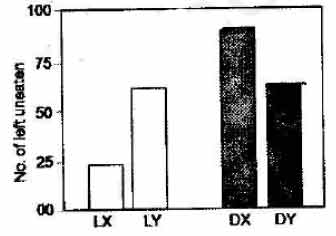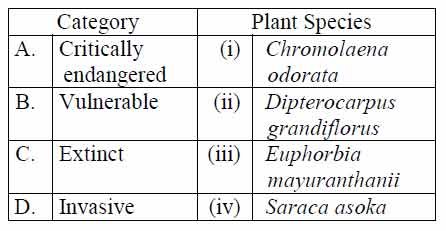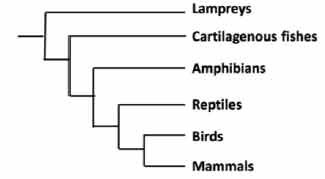Dear Students,
Welcome to Evolution MCQ-08. This MCQ set consists of Advanced (PG Level) Evolution / Phylogeny / Phylogenetics Multiple Choice Questions taken from the previous year question papers of CSIR NET Life Sciences Examination. These questions can be used for the preparation of CSIR NET, ICMR JRF, DBT BET JRF, GATE and other University Ph.D Entrance Examinations.
You may also like: Evolution Notes | Evolution PPT
(1). Given below are some of the methods used to assess evolutionary phylogenetic relationships among plant taxa.
(A). 16S rRNA sequence
(B). Mitochondrial microsatellite
(C). Biochemical characterization
(D). Morphology
Which two of the above methods can best reveal the evolutionary phylogenetic relationships? (CSIR_2015_I)
(a). (A) and (B)
(b). (B) and (C)
(c). (C) and (D)
(d). (A) and (D)
Ans. (a)
(2). Fish species X and Y feed on mayfly nymphs in their stream habitat. In a laboratory experiment, the predation intensity of X and Y on their prey was tested under dark (D) and light (L) conditions. Thus, the experimental protocol included four aquaria – LX, LY, DX and DY. In each aquarium containing 100 mayfly nymphs, one fish was introduced and allowed to feed for 30 minutes. Then the fish was removed and the number of mayfly nymphs left uneaten in each aquarium was counted. The results are shown graphically below.
The most significant conclusion from the results is: (CSIR_2015_I)
(a). X is a visual predator, but has less predation impact on the prey than Y
(b). X is a visual predator and has greater predation impact on the prey than Y
(c). Y is a visual predator and has greater predation impact on the prey than X.
(d). Y is visual predator but has less predation impact on the prey than X
Ans. (b)
(3). Following are the characteristics of species that make them more or less prone to extinction
Which of the following is the correct combination of characteristics that makes the species more prone to extinction? (CSIR_2015_I)
(a). a, d, f, g, j, l, n
(b). a, c, f, h, i, k, m
(c). b, d, e, g, I, l, n
(d). b, c, f, h, j, k, m
Ans. (a).
(4). The following situations might lead to the evolutionary monogyny in birds:
(A). Male has to assist the female in rearing the offspring
(B). Male guards the female against other males trying to mate with her
(C). One male may not produce enough sperm required to fertilize all the eggs produced by the female
Which of the above is/are correct? (CSIR_2015_I)
(a). Only (A)
(b). Only (B)
(c). (A) and (B)
(d). (A) and (C)
Ans. (b)
(5). The body weight of adult female of a strain of Drosophila is 1.8 ± 0.45 (mean ± standard deviation). In a loboratory experiment, each of the 3 groups (A, B, C) of this strain was subjected to a different type of selection pressure having influence on the female body weight. After many generations of experimental selection pressure, the body weight changed as follows:
Group A: Body weight distribution – Normal – 1.08 ± 0.08 mg
Group B: Body weight distribution – Bimodal at 1.4 and 2.2 mg
Group C: Body weight distribution – Normal – 2.2 ± 0.08 mg
Which of the following correctly gives the types of selection that have occurred in the three groups? (CSIR_2015_I)
(a). Group A – Directional; Group B – Stabilizing; Group C – Disruptive
(b). Group A – Disruptive; Group B – Directional; Group C – Stabilizing
(c). Group A – Stabilizing; Group B – Disruptive; Group C – Directional
(d). Group A – Directional; Group B – Disruptive; Group C – Stabilizing
Ans. (c)
(6). A few events in the history of life on earth are given below
(A). Radiation of mammals and birds; Flourishing of insects and angiosperms
(B). Primitive plants and fungi colonize land; Diversification of echinoderms
(C). Seed plants appear; Fishers and Trilobites abundant; earliest amphibians and insects
(D). Earliest birds and Angiosperms appear; Gymnosperms dominant
(E). Invasion of land by primitive land plants and Arthropods
(F). Mass marine extinction; Reptiles radiate; Amphibians decline
Which of the following is correct match of the above events with the geological period during which they had occurred? (CSIR_2015_I)
(a). A: Ordovician; B: Tertiary; C: Permian; D: Silurian; E: Devonian; F: Jurassic
(b). A: Permian; B: Devonian ; C: Silurian ; D: Ordovician; E: Triassic; F: Jurassic
(c). A: Tertiary; B: Ordovician; C: Devonian; D: Jurassic; E: Silurian; F: Permian
(d). A: Permian; B: Devonian; C: Jurassic; D: Tertiary; E: Silurian; F: Ordovician
Ans. (c)
(7). Four different species concepts are given below:
(A). Species separate based on their use of different ecological niches and their presence in different habitats and environments
(B). Differences in physical characteristics or molecular characteristics are used to distinguish species
(C). Species are distinct if they are reproductively isolated.
(D). Phylogenetic trees and analyses of ancestry serve to differentiate species.
Which of the following gives the correct names of the above concepts? (CSIR_2015_I)
(a). (A): Biological; (B): Phylogenetic; (C): Evolutionary; (D): Ecological
(b). (A): Ecological; (B): Phylogenetic; (C): Biological; (D): Evolutionary
(c). (A): Evolutionary; (B): Ecological; (C): Biological; (D): Phylogenetic
(d). (A): Phylogenetic; (B): Evolutionary; (C): Ecological; (D): Biological
Ans. (b).
(8). In a population of effective population size Ne, with rate of neutral mutation μ0, the frequency of heterozygotes per nucleotide site at equilibrium between mutation and genetic drift is calculated as: (CSIR_2015_II)
(a). Option – 1
(b). Option – 2
(c). Option – 3
(d). Option – 4
Ans. (b)
(9). Based on the table given below, which of the following option represents the correct match? (CSIR_2016_I)
(a). A – (i); B – (iv); C – (iii); D – (ii)
(b). A – (ii); B – (iii); C – (iv); D – (i)
(c). A – (i); B – (iv); C – (ii); D – (iii)
(d). A – (ii); B – (iv); C – (iii); D – (i)
Ans. (d)
(10). With reference to the phylogenetic tree presented above, which of the following statements is true? (CSIR_2016_I)
(a). Amphibians, reptiles, birds and mammals share a common ancestor.
(b). Birds are more closely related to reptiles than to mammals.
(c). Cartilagenous fishes are the ancestors of amphibians.
(d). Lampreys and mammals are not related.
Ans. (a)





